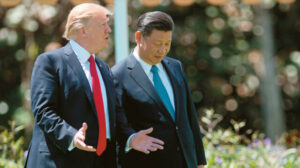The 21st century has so far seen wars in the conventional sense of the term in both the Middle East and Ukraine, and in recent days has also seen the early stages of a global economic and trade conflict. Economic warfare, unlike field warfare, involves the entire planet, although at its core are the two most powerful poles of the global economy, the US and China, are now openly and “formally” pitted against each other, with the first blows from Washington having a corresponding response from Beijing. The White House and President Trump have once again chosen to stay true to what they pledged to do during the election campaign and have put in place a plan with the pompous but not at all optimistic end goal of a ‘liberation day’. The American president should make it clear that he is extremely talented at diagnosing a problem.
Where are we today?
Trump is not wrong that the biggest threat to the US and everything it has built over the last 80 years is Beijing. The US president has correctly diagnosed that China is not the country of the 1980s and 1990s, and has developed an economic and a trade power that can and intends to upend the status quo. The 47th US President, however, is attempting to act first – to take the first shot – and to start a global economic war, knowing full well that in doing so his own losses will be very high. Trump as a doctor would be an ideal pathologist, but he would have serious issues – to recall his own quote about ‘patient’ – with ‘surgical’ procedures.
The US has moved to a Trump-inspired scheme again, talking about a 90-day “freeze” to the entire world which of course is essentially the implementation of a common 10% tariff on all products of all products. Regarding China, Washington is constantly on the offensive and has imposed 145% tariffs on Beijing. It is worth noting that this rate applies to a huge range of products imported into the US, but not to Chinese cars, on which the tariffs exceed 180%. The White House has launched a battle with its big enemy clearly in its sights, but it chooses not to give details of where, how and, above all, with what intensity it is striking Asia. The US moves are indeed causing significant blows to China, but the point is that Trump and his own aggressive tactics can practically threaten Beijing for a long time by going “Checkmate”, but it is very difficult for Washington to reach this chess game in Checkmate.
The Response
For its part, Beijing has responded to Washington as many times as it has been hit with similar actions. Today Chinese tariffs are at 125% and for the first time in decades there is a rivalry in the US. Russia choosing to ignore US warnings in 2021 and ultimately invading Ukraine cannot be considered such a blow, because Russia does not have the caliber of China and the Russian military did not invade US territory… Beijing has seized the opportunity that for years it seems to have been waiting for and is responding not with provocations but by engaging in the field, in fact in the one that the adversary itself has chosen. China with four times as many exports as imports to America is far more “open” but, it seems, also determined to “hurt” if it is to inflict comparable pain.
The “x-ray”
The world’s two largest economies have a trade balance between them which, based on official figures for 2024, was $585 billion. US data imports far more than it exports to China. Chinese imports to the US in 2024 were 440 billion with their exports being about a quarter less at $145 billion. The trade balance between the world’s two largest economies was 295 billion and is in deficit for Washington, which gives about 1% of its GDP to Chinese coffers…
This is not the picture of today, which is precisely why tariffs have been imposed by the US on China – and maintained – and by Joe Biden for the last four years. These tariffs even seem to have had an effect, as since 2016 and Trump’s first term, Chinese imports to the US have fallen from 21% to 13% in 2024. Over the last decade, US dependence on Chinese imports has declined, but it remains very high, especially if one introduces into this mix Washington’s huge fiscal deficit over the last decade (US debt exceeds $33 trillion). China and the US both account for 3% of total trade on the planet and that in itself – at first glance – may seem small, but in real economic terms it is huge.
The balance
But what do China and the US import from each other? The product that is by far the second largest US export to China is soy… For China, soybeans are super valuable, as it doesn’t have the production it needs to feed the more than 440 million pigs it raises… Petroleum products and pharmaceuticals come in second and third respectively for U.S. exports.
For its part, China exports a huge volume of electronics, computers, and toys to the US. Batteries for electric vehicles are also a major export. By far, however, Chinese mobile phones are Beijing’s largest export volume to the US. 9% of all Chinese exports are in the mobile phone sector. Of these devices, nearly 90% are products of Apple, which is literally in the vortex of US tariffs despite being one of the top US companies in terms of both value, marketability and global recognition. Trump’s moves and the trade war now raging openly with China has already cost Apple dearly, which has lost 20% of its share value in a few days…
The consequences
For the most exposed China, the tariffs will bring – and even if they remain in place – significant domestic and economic problems even this year. It is not unlikely that several large Chinese factories will close or suspend operations, leaving hundreds of thousands of workers unemployed. Beijing will have to organise a new rescue plan – bigger and more costly – than the one it put in place five years ago with the scandal and bubble in the construction sector. From this move Beijing is even likely to lose whole points of its GDP and the situation will be a little like that which exists when an unforeseen natural disaster strikes a region… The cost will be heavy, large, painful, but it won’t last forever…
On the flip side, in the US prices on several products will continue to rise. The national government will ask businesses to limit or even contain these increases, but at some point the entire burden will be passed on to consumers, who will either reduce purchases or choose lower value and quality products to meet their needs.
Monetary battle
But the real danger is that the current economic and trade war will turn into a currency battle. Already we have seen reactions that are not purely market related especially in the US. US bonds are already facing shocks and interest rates are already above 5%. The last time something similar happened was in 2020, when of course the whole planet was facing the first economic consequences of the pandemic. It is worth noting that for the specific developments of last week, US economists and analysts do not see a Chinese finger… despite the fact that China alone holds a huge percentage of US debt. In fact, all of the above seems to be an internal message from the US markets themselves to the president of the country, “Systematic cultivation of instability is seriously damaging our economic health.”
In addition to the economic impact, Trump’s tariffs have also brought upheaval at the diplomatic-political level. If two months ago someone had claimed that China, North Korea and Japan would sit at the same table to discuss how to deal with US attacks, few would not have declined Today Trump, needing all his country’s partners more than ever, has already taken care to make it clear that their problems are no longer his. Europe has been getting worrying signals for months now and has taken care to distance itself and to review its own long-standing grievances. The G7 countries, traditional allies of the US, have been targeted by Washington and are looking for ways to fortify themselves on the one hand and to grow towards the East on the other… Trump, by the way he has moved, has essentially broken the “global alliance compass.”
What is expected?
China has made it clear that it will not remain silent this time, although on Friday it stressed that the “reciprocal tariff game” has little substance except for appearances. Trump, who insists on “Xi is my friend”, expects the Chinese president to get on a plane and go to Washington for full-fledged negotiations, a move that would amount to an admission of defeat for China and thus a scenario today more akin to science fiction. At the same time, China has absolutely no hesitation whatsoever in dealing its own cards around the world. The Sanchez-Shi meeting in Beijing at the end of the week may have slipped through the cracks, but it is tangible proof that the Union can talk collectively and that its members are moving unilaterally towards the East in order to reduce the risks as quickly and as much as possible, which is no longer a theory… The Union at the same time is also willing to take advantage of the situation, especially in the face of an ally that had no problem even raising a finger to the rule of law and putting it on the list of “robbers” of its wealth.
The Gap
Europe will also have serious issues with China, as what separates us from the powerful pole in the East is even more than what unites us, but any discussion makes – traditionally – the distances shrink. A comprehensive agreement on all issues with Beijing may seem unattainable today, but a smaller and more targeted one is not unlikely to be reached…
In any case, Donald Trump’s phrase that “there is a big beautiful ocean separating us” seems to have been a pivotal “unwinding salvo”, which in the medium term will bring more problems for everyone. But Europe may at that moment have more than one ally on its side.
Ask me anything
Explore related questions





